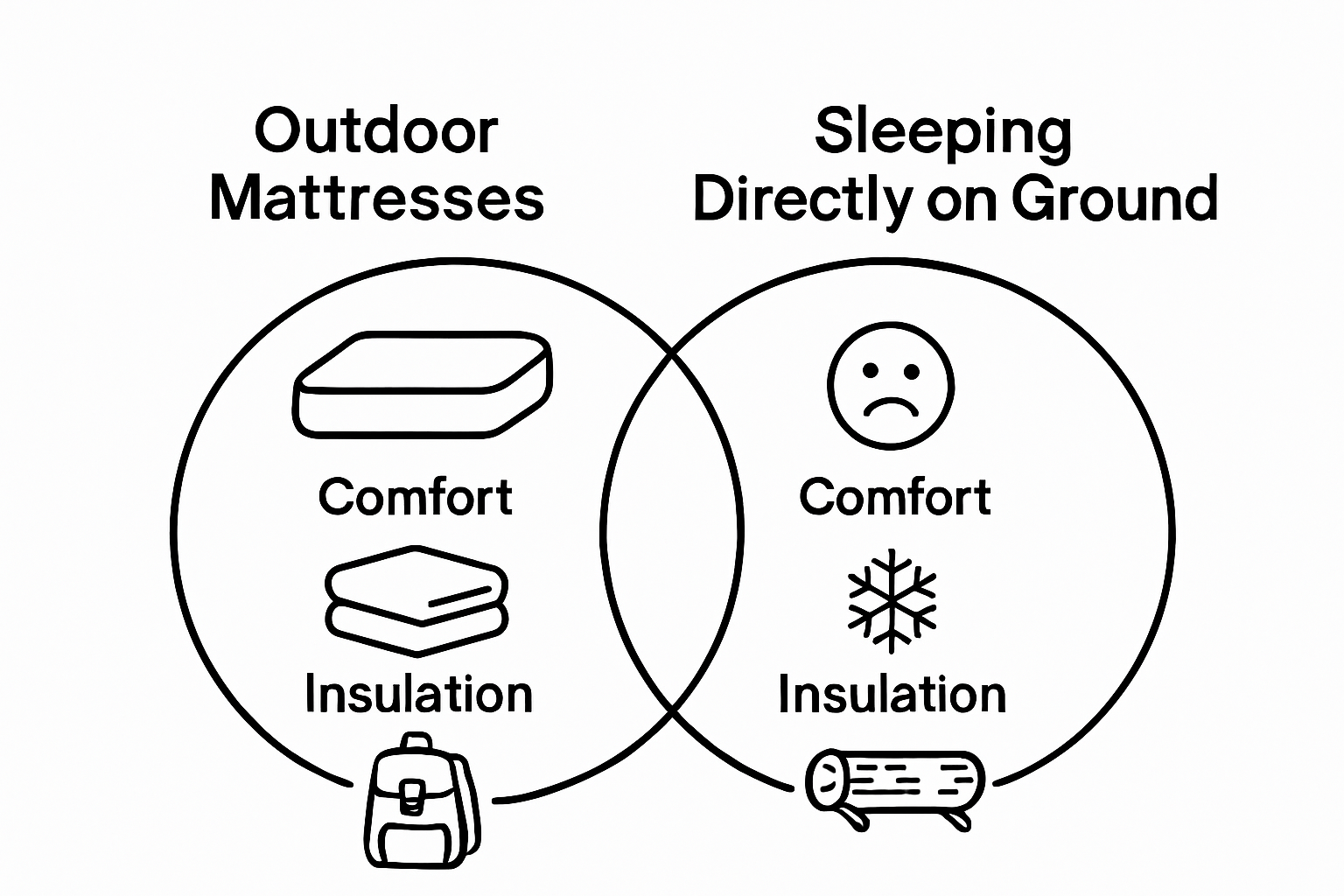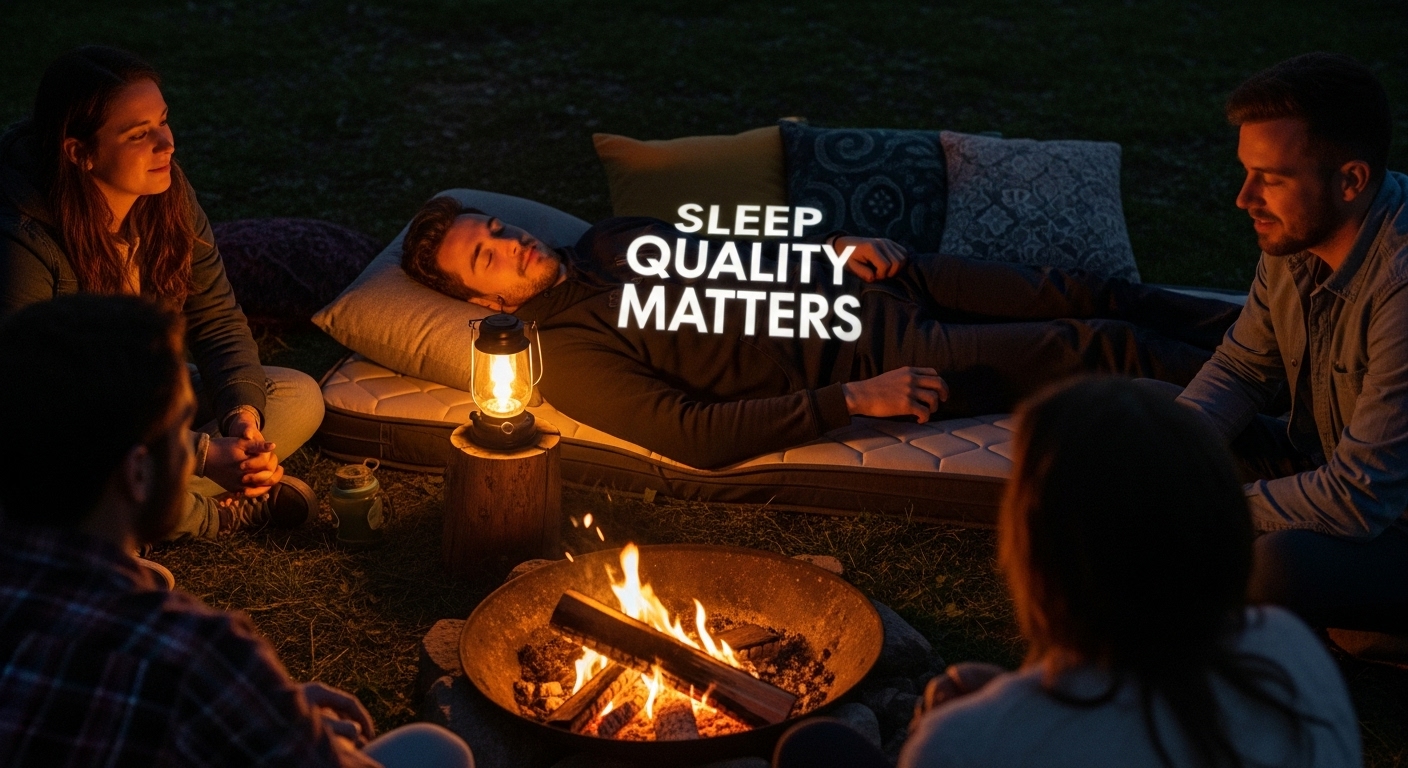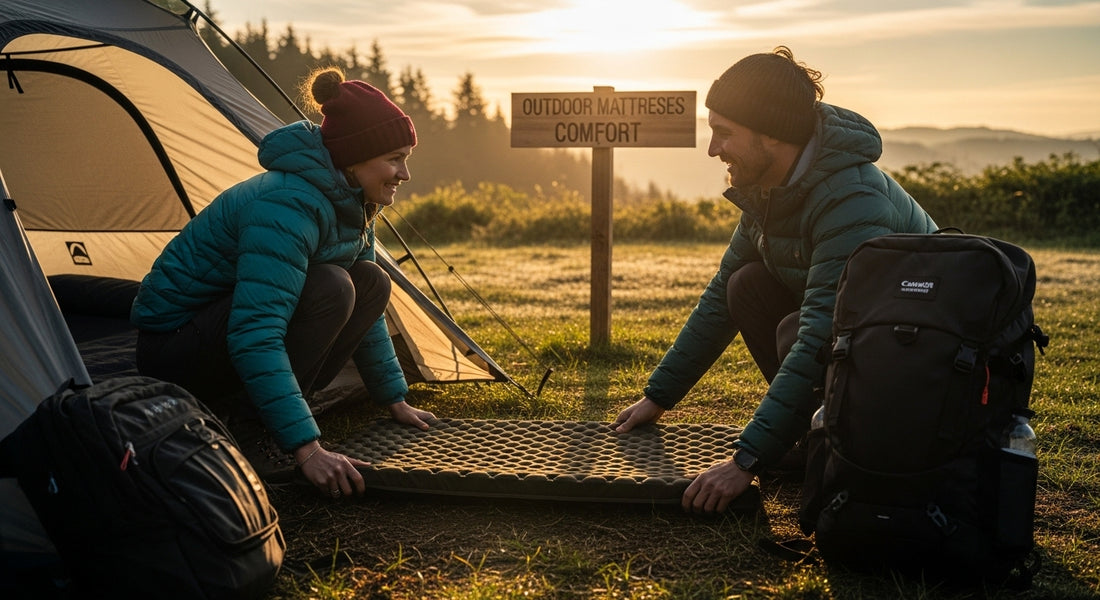Outdoor mattresses are changing how people sleep outside, and their popularity is growing fast. More than 70 percent of campers say that better sleep gear makes them stay longer outdoors. Most expect a thin roll or a flimsy pad, just enough to keep the rocks away. But today’s outdoor mattresses do a lot more than that. They use advanced materials and clever insulation to create a real bed experience in the wild.
Table of Contents
- What Are Outdoor Mattresses And Their Features?
- The Importance Of Comfort In Outdoor Activities
- How Outdoor Mattresses Enhance Your Outdoor Experience
- Key Materials And Technologies Behind Outdoor Mattresses
- Choosing The Right Outdoor Mattress For Your Needs
Quick Summary
| Takeaway | Explanation |
|---|---|
| Choose durable materials for outdoor mattresses | Robust construction ensures resistance to environmental wear and enhances comfort in varied conditions. |
| Look for thermal regulation features | Effective insulation helps maintain body temperature, improving sleep quality during outdoor activities. |
| Understand personal performance needs | Tailor your mattress choice based on terrain, activity type, and personal comfort preferences for optimal outdoor experiences. |
| Evaluate technical specifications like R-value | Higher R-values indicate better thermal resistance, which is crucial for staying warm in cold environments. |
| Portable design is vital for convenience | Lightweight, compact mattresses facilitate easy transport, making them ideal for adventures and camping trips. |
What are Outdoor Mattresses and Their Features?
Outdoor mattresses represent specialized sleeping solutions designed specifically for exterior environments, offering comfort and support beyond traditional indoor bedding. These innovative sleep systems are engineered to withstand challenging outdoor conditions while providing exceptional rest for adventurers, campers, and outdoor enthusiasts.
Construction and Material Design
Unlike standard indoor mattresses, outdoor mattresses are crafted with robust materials capable of resisting environmental challenges. Research on thermal comfort suggests that effective outdoor mattresses must address multiple performance criteria:
- Moisture resistance to prevent water absorption
- Temperature regulation capabilities
- Durability against punctures and external damage
- Lightweight construction for portability
Typical outdoor mattress materials include high-density polyurethane foam, ripstop nylon, waterproof polyester, and specialized synthetic fabrics that maintain structural integrity in variable weather conditions. These materials are selected to provide optimal comfort while ensuring maximum protection against environmental elements.
Performance and Functionality
Outdoor mattresses distinguish themselves through unique performance characteristics. They are typically designed with specialized features that traditional indoor mattresses cannot provide. Compression resistance ensures the mattress maintains its shape under uneven terrain, while thermal insulation prevents heat loss during cooler outdoor nights.
Key functional aspects include rapid inflation mechanisms, compact folding designs, and integrated protective layers that shield sleepers from ground moisture and temperature fluctuations. Some advanced models incorporate air chambers and adjustable firmness settings, allowing users to customize their sleeping experience based on specific environmental conditions and personal comfort preferences.
The primary goal of outdoor mattresses is to transform challenging exterior sleeping environments into comfortable, supportive rest zones. By combining innovative material science with practical design principles, these specialized sleep solutions enable outdoor enthusiasts to enjoy restful experiences regardless of location or environmental conditions.
To clarify the main features that set outdoor mattresses apart from traditional sleeping gear, the following table summarizes their key characteristics and benefits.
| Feature/Characteristic | Description |
|---|---|
| Durability | Built with robust materials to withstand punctures, moisture, and rough terrain |
| Moisture Resistance | Designed to prevent water absorption and keep users dry |
| Thermal Regulation | Insulation layers help maintain body temperature in varying weather |
| Lightweight Construction | Engineered for easy transport and portability |
| Compression Resistance | Maintains shape on uneven or rough ground surfaces |
| Rapid Inflation Mechanisms | Allows for quick setup and takedown in outdoor settings |
| Adjustable Firmness Options | Some models let users tailor firmness for personalized comfort |
| Protection from Ground Elements | Shields sleepers from ground cold and moisture |
The Importance of Comfort in Outdoor Activities
Comfort plays a pivotal role in transforming outdoor experiences from mere survival scenarios to enjoyable adventures. Understanding the intricate relationship between physical comfort and overall outdoor performance helps enthusiasts maximize their engagement with nature while maintaining personal well-being.
Psychological and Physical Impact
Research from Oregon State University demonstrates that outdoor activities significantly contribute to mental and physical health. Comfort becomes a critical factor in determining an individual’s willingness to participate and remain engaged in outdoor experiences. When individuals feel physically comfortable, they are more likely to:
- Extend their time outdoors
- Reduce stress and anxiety
- Improve overall mental resilience
- Enhance cognitive performance
Physical comfort directly influences psychological states, creating a positive feedback loop that encourages continued outdoor exploration. Discomfort, conversely, can quickly diminish motivation and lead to premature retreat from outdoor environments.
Environmental Adaptation and Performance
Outdoor comfort is not merely about feeling pleasant but represents a complex interaction between human physiology and external environmental conditions. Thermal regulation becomes a critical component in maintaining optimal performance during outdoor activities. The body expends significant energy maintaining core temperature, and comfortable sleeping and resting environments can dramatically reduce physical strain.
Advanced outdoor gear, including specialized mattresses and thermal-adaptive clothing, helps mitigate environmental challenges. These technologies enable outdoor enthusiasts to maintain stable body temperatures, reduce fatigue, and extend their capacity to enjoy and perform in diverse environmental conditions.
Ultimately, comfort in outdoor activities transcends physical pleasure.
It represents a strategic approach to human performance, psychological well-being, and sustainable engagement with natural environments. By prioritizing comfort through intelligent equipment choices and understanding individual physiological needs, outdoor enthusiasts can transform challenging experiences into memorable, enriching adventures.
How Outdoor Mattresses Enhance Your Outdoor Experience
Outdoor mattresses are not simply accessories but transformative tools that significantly elevate the entire outdoor recreation experience. These specialized sleep systems bridge the gap between challenging natural environments and personal comfort, enabling adventurers to maintain peak performance and enjoyment during their expeditions.
Comfort and Performance Optimization
Research published in PubMed demonstrates that using a proper mattress dramatically improves sleep quality compared to sleeping on hard, uneven surfaces. Outdoor mattresses offer critical advantages that directly impact user experience:

- Pressure point reduction
- Enhanced body temperature regulation
- Protection from ground moisture and temperature variations
- Improved sleep quality in challenging environments
By mitigating physical discomfort, these mattresses allow outdoor enthusiasts to wake up refreshed and ready for daily activities, preventing fatigue and potential performance limitations associated with poor sleep conditions.

Psychological and Physical Resilience
Thermal management represents a crucial element in outdoor mattress design. These innovative sleep solutions actively counteract environmental challenges by providing insulation and temperature stabilization. The psychological impact of feeling comfortable in potentially harsh conditions cannot be overstated.
Outdoor mattresses engineered with advanced materials help maintain a consistent microclimate around the body. This consistent thermal environment reduces stress, conserves energy, and promotes faster recovery after intense physical activities. The ability to create a personal comfort zone amid unpredictable outdoor settings transforms potentially challenging experiences into enjoyable adventures.
Moreover, these mattresses serve as more than just sleeping platforms. They become portable sanctuaries that provide psychological reassurance, enabling adventurers to feel secure and supported regardless of their surrounding environment. By bridging the gap between human comfort needs and natural landscape challenges, outdoor mattresses represent an essential tool for modern explorers seeking reliable, comfortable outdoor experiences.
Key Materials and Technologies Behind Outdoor Mattresses
Modern outdoor mattresses represent a sophisticated convergence of advanced materials science and innovative engineering principles. These sleep systems are meticulously designed to meet the complex demands of challenging outdoor environments, integrating cutting-edge technologies that transform traditional sleeping experiences.
Advanced Material Composition
ASTM International’s standard F3340 highlights the critical importance of thermal performance in outdoor mattress design. The material selection process involves sophisticated considerations:
- Lightweight synthetic polymers
- High-density closed-cell foam
- Waterproof and moisture-wicking fabrics
- Puncture-resistant outer layers
These materials are strategically layered to create multifunctional sleep surfaces that provide insulation, durability, and comfort. Synthetic fabrics like ripstop nylon and polyester offer exceptional strength-to-weight ratios, enabling manufacturers to produce mattresses that are simultaneously robust and portable.
Thermal Regulation Technologies
Thermal management represents a critical technological frontier in outdoor mattress development. Innovative designs incorporate specialized insulation technologies that actively manage heat transfer between the human body and the surrounding environment. Modern outdoor mattresses utilize complex internal structures that trap air molecules, creating thermal barriers that prevent heat loss and maintain consistent body temperature.
The integration of advanced thermal technologies allows outdoor mattresses to function across diverse environmental conditions. Some cutting-edge models incorporate phase-change materials that absorb, store, and release heat, providing dynamic temperature regulation. These intelligent material systems automatically adjust to ambient temperature fluctuations, ensuring users remain comfortable regardless of external climate challenges.
By combining sophisticated material engineering with intelligent thermal technologies, outdoor mattresses have evolved from simple sleeping platforms to sophisticated environmental adaptation systems. These innovative sleep solutions represent a remarkable intersection of materials science, thermal engineering, and human comfort optimization.
Choosing the Right Outdoor Mattress for Your Needs
Selecting an appropriate outdoor mattress requires careful consideration of multiple factors that extend beyond basic comfort. The right mattress can significantly enhance outdoor experiences, providing critical support and protection in diverse environmental conditions.
Personal Performance Requirements
Research from RTI International suggests that personal mattress selection is complex and requires thorough evaluation. Outdoor enthusiasts must consider several key performance criteria:
- Expected terrain conditions
- Anticipated temperature ranges
- Personal body weight and sleeping preferences
- Specific outdoor activity type
- Transportation and storage limitations
Understanding individual requirements helps narrow down the vast array of outdoor mattress options, ensuring a targeted selection that meets specific outdoor adventure needs.
Technical Evaluation Criteria
Thermal resistance represents a critical technical specification when choosing outdoor mattresses. The mattress’s ability to provide insulation against ground temperature is measured through its R-value, which indicates heat transfer prevention capabilities. Higher R-value ratings signify superior thermal protection, crucial for maintaining body temperature in challenging outdoor environments.
Beyond thermal properties, factors like weight, packed size, durability, and inflation mechanism play significant roles in mattress selection. Ultralight backpackers might prioritize compact, lightweight designs, while car campers could focus on thicker, more luxurious options that provide enhanced comfort.
Ultimately, choosing the right outdoor mattress is a personalized decision that balances technical specifications with individual comfort preferences.
To further aid the decision-making process when selecting an outdoor mattress, the table below compares key technical criteria you should evaluate based on your specific needs and preferences.
| Evaluation Criterion | Importance | Considerations |
|---|---|---|
| Terrain Adaptability | Ensures comfort and stability on different ground surfaces | Rocky, soft, or uneven terrain |
| R-value (Thermal Rating) | Indicates insulation effectiveness for temperature control | Higher R-value for colder conditions |
| Weight & Packed Size | Affects ease of transport and suitability for your activity | Backpacking vs. car camping requirements |
| Durability | Measures resistance to wear and environmental exposure | Frequency of use and expected roughness |
| Inflation Mechanism | Determines operational simplicity and setup speed | Manual, self-inflating, or pump-assisted types |
| Comfort/Firmness Options | Influences sleep quality and personal comfort preferences | Adjustable or fixed firmness |
Upgrade Every Outdoor Night With Hazli Collection’s Sleep Solutions
Getting a good night’s sleep outdoors is often the biggest challenge for campers and adventurers. Hard ground, unpredictable weather, and lack of thermal regulation can leave you restless and uncomfortable. If you have ever struggled with poor sleep quality or waking up sore during your outdoor excursions, you already know how much the right mattress matters. The article highlights the critical need for comfort, thermal insulation, and durability in outdoor mattresses. That is exactly where Hazli Collection steps in to help you rest easy and wake up refreshed for any adventure.

Discover the comfort upgrade you deserve with Hazli’s high-quality memory foam outdoor mattresses. Our selection is engineered to protect against ground moisture, regulate temperature, and reduce pressure points so you feel at home anywhere. Each mattress is crafted with adventure and relaxation in mind, helping you transform your sleep experience outdoors. Don’t let another trip be ruined by discomfort. Visit Hazli Collection today and find the perfect outdoor sleep solution that matches your needs. Take action now for restful nights and better days under the open sky.
Frequently Asked Questions
What are outdoor mattresses made of?
Outdoor mattresses are typically constructed from high-density polyurethane foam, ripstop nylon, waterproof polyester, and specialized synthetic fabrics. These materials are designed to be durable, lightweight, and moisture-resistant, making them ideal for outdoor conditions.
How do outdoor mattresses improve sleep quality while camping?
Outdoor mattresses enhance sleep quality by providing pressure point reduction, better body temperature regulation, and protection from the cold ground and moisture. This comfort helps users wake up feeling refreshed and ready for outdoor activities.
What should I consider when choosing an outdoor mattress?
When selecting an outdoor mattress, consider factors such as the expected terrain conditions, anticipated temperature ranges, your body weight, sleeping preferences, and specific outdoor activities planned. Additionally, evaluate the mattress’s weight, packed size, and thermal resistance (R-value).
How do outdoor mattresses manage temperature during use?
Outdoor mattresses incorporate thermal management technologies that help regulate temperature. They often feature insulation layers and materials that trap air, creating thermal barriers to prevent heat loss. Some models even use phase-change materials that adapt to temperature changes, ensuring comfort in diverse conditions.

